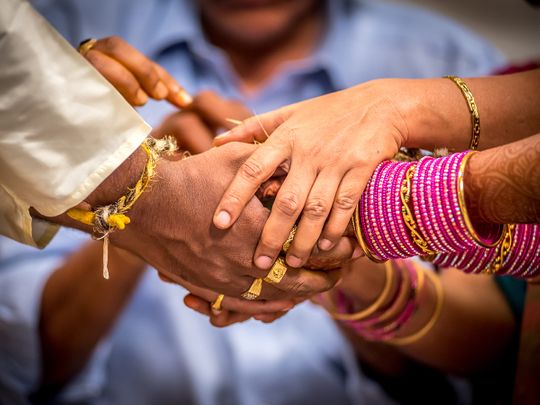
Patriarchy in Indian society is like those cement advertisements on television, you can keep hammering at the wall even with a sledgehammer, but there is not even a dent, and the tagline says, sabze mazboot.
How else do you make sense of the huff and puff on twitter over a commercial by a bridal clothing brand that questions kanyadaan, the archaic wedding ritual of giving away (daan) the daughter (kanya) at the wedding mandap, sugar coating it in tradition does not make it any sweeter.
To be honest, the advertisement is as neutral as a parent with two children, it ends with the families of both the groom and the bride jointly partaking in the ceremony. But pause and reflect is not part of any outrage manual neither does sexism feed on equality.
On the contrary any questioning of a traditional status quo- even a healthy Diwali without crackers- these days conveniently becomes either an attack on faith or is dissed as feminism.
Majority of the latest frothing has been by men who remain lazy in laying this- as most everything- at the doorsteps of the ‘liberals’ but are completely silent on why this custom is only performed by the father or a male member of a family.
The fight for gender equality must have a semblance of emotional anxiety among the dominant sex, after all a woman getting an agency over her own life was never a given in our country. Nor is choice, brides just go along- whether they agree or not- to being gifted as a commodity.
Some women have only made it tougher for the daughters by joining the herd in this ‘attack on faith’ but then patriarchal bargain- the Faustian compromise by women in societies where they find their own power in a misogynist set-up- is something I have written about earlier. It often includes the educated.
Reading the wrong syllabus
The recent outrage- you are forgiven if you have lost count- includes gems like ‘kanyadaan makes parents fortunate’ or ‘charity is the best dharma and Kanyadaan is the best charity.’
Many of us are reading the wrong syllabus- both in life and in text- books these days, else Bollywood which has beautified the burden of being a beti- daughter, has done its thing.
The misogynist tones haven’t spared politics either, singer turned politician Babul Supriyo taunted Mamata Bannerjee with ‘paraya dhan’ or someone else’s property at the elections but has himself come back to Mamata’s fold.
Some traditions have an expiry period and kanyadaan is an idea whose time has long gone but a society on edge weighs everything through blinkers and any talk of reforms becomes a religious affront.
The latest round of chest beating in the name of faith is no different from the faux nationalists sitting comfortably on the couch in their living rooms and preaching about the border.
It is all done from the confidence of social media distance where angry young men- even Amitabh Bachchan in Namak Haram or Zanjeer seems a jolly fellow in comparison- proclaim every ill they can think of but will never look within their own belief. Majoritarianism by itself gives a hall pass.
There is woke and then there is regressive
Either way, the othering remains convenient. A jewelry advertisement some months earlier that showed an inter-faith ceremony was a wound so superficial that the brand showrooms were attacked, forcing the commercial to be withdrawn.
There is woke and then there is regressive, Kanyadaan is a parampara or a custom that should have been left behind in the Vedic era, much like child marriage and dowry it has no place in today’s times, although it is hard to justify it at all.
But today when many women are earning their own financial stability, this ritual serves no purpose other than its defence as an ancient custom. Frankly, we have enough lovely traditions to tide us through more than one wedding!
In the late 1930s, a woman way ahead of her times refused the kanyadaan of her daughter saying she wasn’t giving away her child and was instead only marrying her. That marriage took place, and the bride was my paternal grandmother.
Years later my academician maternal grandfather and Hindi, Sanskrit scholar grandmother did the same with my mother, choosing to simply bless the couple. Our tradition continues, the ritual was omitted at my wedding and will not find a place in the future either.
Change they say, begins at home.









